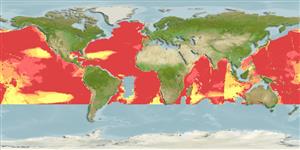Environment: milieu / climate zone / depth range / distribution range
Ökologie
seewasser bathypelagisch; tiefenbereich 701 - 2868 m (Ref. 96339). Deep-water; 65°N - 35°S, 180°W - 180°E (Ref. 57326)
Circumglobal. Eastern Atlantic: Iceland, and from France south to Morocco including Madeira and Azores Islands; Mauritania south to Guinea Bissau (Ref. 4460). Reported from Western Australia and New South Wales (Ref. 7300).
Size / Gewicht / Alter
Maturity: Lm ? range ? - ? cm
Max length : 13.0 cm SL Männchen/unbestimmt; (Ref. 96339)
Meso- and bathypelagic (Ref. 58302). Found in areas with steeply inclined slopes. Ovarian eggs relatively large (1.8 mm in diameter) and few (96 in a female of 10 cm).
Life cycle and mating behavior
Geschlechtsreife | Fortpflanzung | Ablaichen | Eier | Fecundity | Larven
Markle, D.F. and J.-C. Quéro, 1984. Alepocephalidae (including Bathylaconidae, Bathyprionidae). p. 228-253. In P.J.P. Whitehead, M.-L. Bauchot, J.-C. Hureau, J. Nielsen and E. Tortonese (eds.) Fishes of the North-eastern Atlantic and the Mediterranean. UNESCO, Paris. Vol. 1. (Ref. 4736)
IUCN Rote Liste Status (Ref. 130435)
Bedrohung für Menschen
Harmless
Nutzung durch Menschen
Fischereien: nicht kommerziell
Mehr Information
NamenSynonymeMetabolismusRäuberÖkotoxikologieFortpflanzungGeschlechtsreifeAblaichenSpawning aggregationFecundityEierEientwicklung
Alter/Größe
Wachstum
Länge-Gewicht
Länge-Länge
Längenhäufigkeiten
Morphometrie
Morphologie
Larven
Larven Pop.Dyn.
Rekrutierung
Dichte
BRUVS
ReferenzenAquakulturAquakultur ProfilZuchtlinienGenetikElectrophoresesVererbbarkeitKrankheitenVerarbeitungNutrientsMass conversion
PartnerBilderStamps, Coins Misc.LauteCiguateraGeschwindigkeitSchwimmstilKiemenoberflächeOtolithsGehirngrößeSehfähigkeit
Tools
Zusatzinformationen
Download XML
Internet Quellen
Estimates based on models
Preferred temperature (Ref.
123201): 2.9 - 6.3, mean 4 °C (based on 1957 cells).
Phylogenetic diversity index (Ref.
82804): PD
50 = 1.0000 [Uniqueness, from 0.5 = low to 2.0 = high].
Bayesian length-weight: a=0.01000 (0.00244 - 0.04107), b=3.04 (2.81 - 3.27), in cm total length, based on all LWR estimates for this body shape (Ref.
93245).
Trophic level (Ref.
69278): 3.4 ±0.5 se; based on size and trophs of closest relatives
Widerstandsfähigkeit (Ref.
120179): niedrig, Verdopplung der Population dauert 4,5 - 14 Jahre. (Fec=96).
Fishing Vulnerability (Ref.
59153): Low vulnerability (10 of 100).
